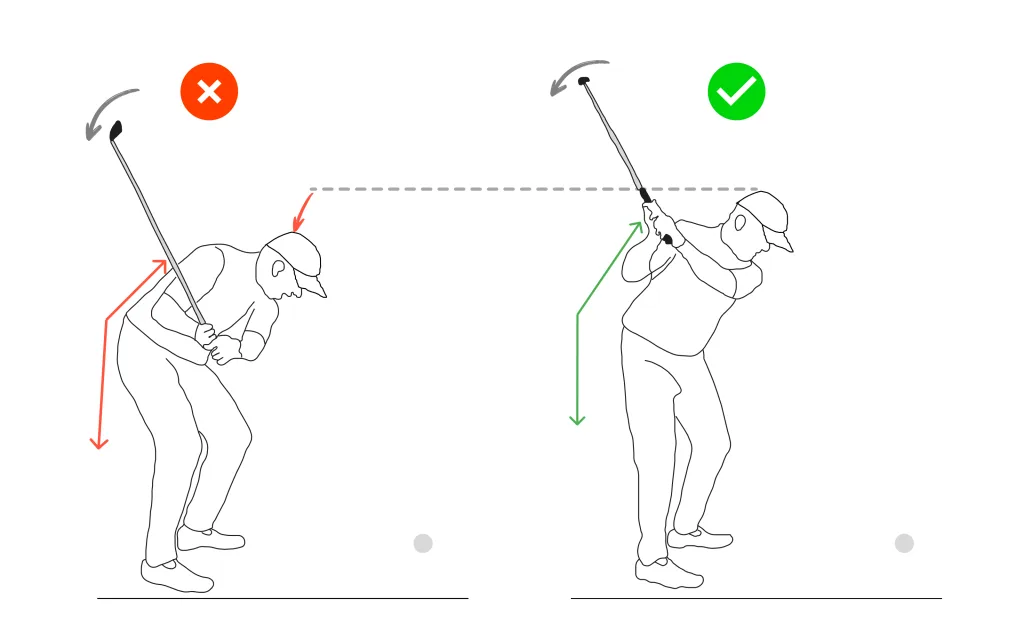
Dipping your head during a downswing can cause you to hit the ball behind the club or chunk the shot. A chunk is a mishit where the club hits the ground before
Dropping your head too much during your downswing can compromise your swing and cause you to lose consistency and timing. Ideally, you should keep your head in the same position throughout your downswing.
Alternate Names
- Head drop
Causes of dipping head in downswing
Utilize different social media platforms to promote your blog posts. Tailor your approach for each platform to maximize engagement.
Collaborations can introduce your blog to new audiences. Consider guest posting, interviews, or joint social media promotions.
Golf Technique Deficiency
Poor Spine Angle – Starting with an overly rounded back or slouched posture can lead to a loss of posture during the swing.
Excessive Knee Flex – Too much knee bend at address can make it harder to maintain a stable lower body, causing the head to dip.
Overuse of the Upper Body – An over-aggressive move with the shoulders or arms during the downswing can cause the upper body to collapse downward.
Early Extension or Hip Movement – A lack of proper hip rotation or sliding hips can force the upper body to dip to compensate.
Excessive Lateral Movement – Shifting weight too far forward or backward can destabilize the swing, leading to a dipping motion.
Drills to Fix the Issue
Head Still Alignment Stick Drill
Trains head stability and posture retention throughout the swing using a visual feedback tool.
- Place your golf ball on the ground, and your golf kit directly in front of it (infront of you).
- Insert an alignment stick vertically into your golf bag, adjusting it so that the tip of the stick gently touches your head when you’re in your address position.
- Take your normal golf stance, ensuring you’re comfortable but making light contact with the stick.
- Perform your golf swing while keeping your head steady, maintaining gentle contact with the alignment stick throughout.
- Avoid swaying, lifting, or pulling away — any head movement will cause the stick to shift or lose contact.
- Repeat slowly to build the feel of maintaining posture and head position.
🎯 Goal: Prevent excessive head movement and maintain a steady spine angle through the swing for more consistent ball striking.
Belt Tilt Stability Drill
Prevents head dipping in the downswing by promoting proper lower body tilt and maintaining spine posture.
- Take your normal golf stance.
- Swing back smoothly, staying balanced.
- In the downswing , focus on keeping the trail side of your belt slightly lower than the lead side.
- This subtle tilt keeps your upper body from collapsing downward and helps maintain your spine angle.
- Avoid dropping your head or over-flexing your upper body — let the lower body guide the motion.
- Repeat to build the feeling of staying tall and connected through impact.
🎯 Goal: Eliminate head dipping by using proper hip tilt to stabilize posture and control the downswing.
Kneeling Swing Drill
Builds awareness of head stability and posture by exaggerating the feel of dipping during the swing.
- Tee up a golf ball at a comfortable height.
- Kneel down on both knees directly behind the ball, maintaining balance and posture.
- Take your normal grip and address the ball while kneeling.
- Make a slow, controlled swing.
- If you dip your head or upper body, you’ll immediately feel a loss of balance or awkward movement.
- Focus on keeping your head level and upper body stable throughout the swing.
🎯 Goal: Prevent head dipping by training balance, body control, and awareness of upper body movement.
Physical Limitations Contributing to the Error
Weak Core Muscles – A weak core can make it difficult to maintain posture and balance throughout the swing.
Poor Flexibility – Tight hips, hamstrings, or lower back muscles can limit your ability to rotate and maintain an upright position.
Lack of Strength – Insufficient lower-body or upper-body strength can make it harder to stabilize during the downswing.
Exercises to Build Movement Capacity
Cat-Cow Stretch – Builds spine mobility and awareness.
Bird Dogs – Improves core and back stability.
Wall Angels – Opens up the upper back to allow better posture control.
How to Adapt Your Swing to Physical Limitations
- Use a shorter swing with more control to reduce need for deep compression.
- Maintain a slightly taller posture at address to reduce the urge to drop.
- Focus on turning around your spine, not collapsing into it.
Related Swing Errors
Precursor Errors (Triggering Issues)
- Too much knee bend at setup – Encourages downward momentum.
- Over-flexed spine posture – Makes staying level harder.
Successor Errors (Resulting Issues)
- Thin or chunked shots – From changing spine angle mid-swing.
- Early extension – Hips thrust forward to rebalance from head dip.
Tools and Training Aids
- Cap with Hanging String/Ball – If the ball swings too much, your head moved.
- Alignment Stick Behind Head – Physical reference for head position.
- Mirror or Video Feedback – To monitor head level throughout swing.
GolfWiz Plus Point–
Could Head Dipping At Impact Be Good?
A little head dip in your downswing isn’t always a mistake—in fact, it might be your secret to more power. Watch the likes of Tiger Woods, Rory McIlroy, or Jon Rahm, and you’ll notice their heads lower slightly—about 1–2 inches—right as they transition from the top. This controlled move helps them load into the ground, build torque, and explode through the ball with precision. Far from being a swing flaw, it’s a sign of athletic intent—just as long as it’s not overdone or carried into impact.
